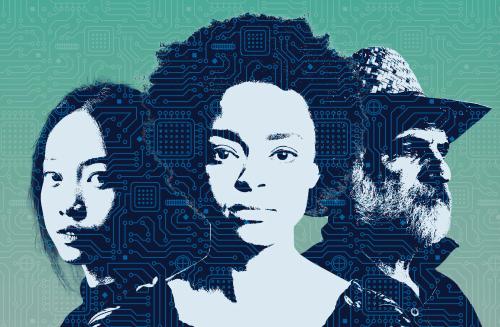President Joe Biden is encountering fires on many fronts as he takes office, among them a level of joblessness not seen since the Great Depression. Our policy response to the previous recession ended too soon and left 53 million Americans stuck in low-wage jobs. There are no silver bullets for the COVID-19 recession, but having Democratic control over the presidency, House, and Senate now presents a rare opportunity to get beyond partisan friction and implement multipronged solutions for a more inclusive recovery.
One of these holistic solutions is to adapt apprenticeship for today’s economy and make it a more integral part of our education and training ecosystem in order to increase access to quality jobs, especially for young people—a group that has suffered the greatest job losses in the current recession. Apprenticeships, which combine on-the-job and classroom training over several years, can help people get a foot in the door to the labor market while also increasing access to higher education. They also help meet employers’ needs for a workforce with applied, technical, and problem-solving skills. Many peer countries are farther along in pursuing such education reform that promotes ongoing learning for a fast-paced 21st century economy.
Apprenticeships have a long history in the U.S., but they have yet to be widely adopted outside trades such as construction and utilities. Below, we examine the apprenticeship system in the U.S., review the key reasons for and elements of reform, and assess the extent to which a proposed update to the National Apprenticeship Act of 1937 makes progress toward a broader education reform effort.
Apprenticeship in America
In the U.S., the 1937 National Apprenticeship Act governs the formal Registered Apprenticeship system, establishing labor standards to safeguard the welfare of apprentices, a process for approving them, and advisory councils. This legislation has not been substantially updated in over 80 years, so it is not easily adapted for use in many growing industries such as health care and technology. As a relatively small and standalone system available primarily in the trades, apprenticeships are not well integrated with the education or workforce training ecosystem more broadly. In 2017, Harvard researchers estimated that apprenticeships could be expanded from 27 to 74 occupations and that we could fill more than eight times the number of job openings with apprenticeships—up to roughly 3.2 million jobs. There is also tremendous grassroots enthusiasm for expanding and modernizing apprenticeships.
Apprenticeship expansion has proceeded in three ways. First, there have been consistent bipartisan efforts to expand Registered Apprenticeships—first through a 2008 update to federal regulations and subsequently through expansion grants. The Department of Labor administered almost $250 million in active apprenticeship expansion grants for 2020 alone. From 2009 to 2019, the number of active Registered Apprentices grew by 51%, to 633,476.
Second, there is growing support for expanding youth apprenticeships, as they have become the “gold standard” globally for getting youth into quality jobs. These combine work experience with classroom education beginning in high school.
Lastly, in 2017, former President Donald Trump created Industry-Recognized Apprenticeship Programs (IRAPs) through an executive order, which operate outside the Registered Apprenticeship system. IRAPs are run by employers and recognized by a third party, which can include corporations or industry trade associations. The executive order states that the IRAP model was created to reduce the “regulatory burden” of employer participation in apprenticeships—suggesting a lack of faith that the existing system can be flexible enough to respond to employer needs. But critics argue this waters down protections for apprentices.
How to reform apprenticeships
A robust apprenticeship system has the potential to increase earnings and reduce occupational segregation in the labor market. A recent study of the benefits for employers also found evidence for a return on investment (though it varies by country) and that it improves retention, among other benefits. Other evidence suggests that apprenticeships are an effective workforce development strategy that provides a net benefit to society.
However, to fully realize these benefits, we need to reach a point where our programs and partnerships are more functional across the apprenticeship ecosystem. Many of the stumbling blocks are cultural. For example:
- There is a misperception that apprenticeships are only an option in the trades and that they require a labor union to be registered.
- Many employers believe that the process of registering apprenticeships is onerous; for example, the need to re-register the same program in multiple states.
- There is a normative perception among parents and students that apprenticeships have lower social status than a college degree (and many are unaware that apprenticeships can also lead to a degree).
- Many employers are not sufficiently organized at the sector level to speak in a unified voice to articulate skill needs and competency levels by occupation.
Additionally, the broader ecosystem of education and training in the U.S. is highly decentralized and fragmented, often confusing and frustrating workers and employers alike. For example, most of our workforce training options are unaccredited, and we lack a policy framework to enable learners to easily advance or transfer credit. U.S. education systems typically lack scheduling flexibility to accommodate apprenticeships. And when creating a new apprenticeship program, intermediaries often report needing to seek approval from multiple governing bodies (e.g., accreditation boards, career-technical education or K-12 systems, apprenticeship councils), which tends to happen one region or employer at a time rather than scaling statewide.
Lastly, the funding to expand apprenticeships has largely come in the form of time-limited grants, rather than stable funding streams available systemwide. This leads to many challenges for recruiting and retaining quality staff and sustaining programs after the grant period.
Our recent research brief in Brookings’s Blueprints for American Renewal & Prosperity laid out a vision for scaling “earn-and-learn” strategies (such as apprenticeships) that is integrated into the broader education and training ecosystem. To be effective, these reforms must balance being employer-driven and student-centered, as well as be quality-focused and user-friendly. In addition, we called for an intentional focus on equitable access, given the poor track record of gender diversity in Registered Apprenticeships and the history of racialized tracking in education more broadly.
A new National Apprenticeship Act
Reauthorizing the 1937 National Apprenticeship Act would be a critical step toward systems change. In November, the House of Representatives passed the National Apprenticeship Act of 2020, which aimed to strengthen apprenticeship expansion efforts. The proposed legislation authorized up to an additional $3.89 billion in funding over five years, including up to $420 million for federal-level modernization and expansion, $475 million for state allotments, and $3 billion in grants. This would have more than doubled current levels of grant funding for apprenticeship expansion. A bipartisan group from the House Committee on Education and Labor unveiled similar draft legislation on January 25th.
The proposed legislation emphasized greater awareness of modern apprenticeships among key stakeholders, alignment, and technical assistance. Increased support for intermediaries, as proposed, would have helped address the awareness gap, engage employers, and increase access for underrepresented groups. The bill also stressed the importance of enhanced data systems and research.
However, the proposed legislation does not significantly respond to employers’ concerns about the onerous registration process. While it does require federal administrators to review registration processes, it does not authorize substantial investments in business process re-engineering or user-centered design.
The House bill established a national advisory committee and reauthorized state advisory councils, which each have some employer representation. Arguably, however, these changes do not offer a major expansion of opportunities for employers or employer-led organizations to more meaningfully shape apprenticeship expansion, except for a handful of employers involved at the highest level in an advisory capacity. Additionally, the duties of the apprenticeship committees and councils seem to duplicate some activities of other governing bodies in education and training programs, such as college advisory councils or workforce development boards. Thus, the legislation, as proposed, doesn’t address the need for more streamlined governance and authority structures.
Now is the time to modernize apprenticeships
January’s U.S. Senate runoff elections in Georgia—which delivered control of Congress to Democrats—make a long-overdue update to the National Apprenticeship Act more feasible, if only because Democrats are more inclined to call it up for a vote. Modernizing apprenticeship legislation has bipartisan support, and the right bill would represent a major step forward in establishing broader reform.
However, policymakers must do more to address duplication in governance and find more effective ways of engaging employers across systems without eroding labor or quality standards. Policymakers could consider gathering user feedback to continuously improve the process to make participation easier for employers and apprentices. As the COVID-19 recession engenders an uncertain and turbulent labor market—especially for the nation’s youth—it would be a missed opportunity not to pursue more transformative updates to the apprenticeship system and take advantage of the quality jobs and innovation it can bring.
The Brookings Institution is committed to quality, independence, and impact.
We are supported by a diverse array of funders. In line with our values and policies, each Brookings publication represents the sole views of its author(s).








Commentary
Apprenticeships are an overlooked solution for creating more access to quality jobs
January 27, 2021